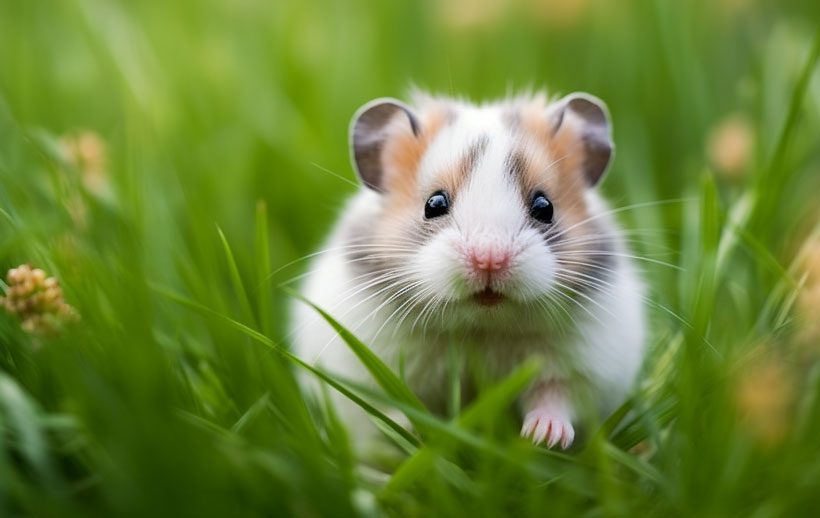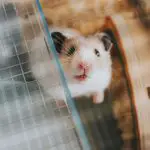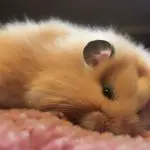Russian Hamster Care Sheet: Food, Habitat, Health, and Facts
If you are a new or experienced owner of a Russian hamster, it’s essential to provide your furry friend with the best care possible. These small but active creatures are known for their energetic personalities and easy-to-maintain habitats. However, proper care is vital to ensure their longevity and happiness.
So, what is a Russian hamster, and how do you take care of it? Russian hamsters are small rodents that are native to Siberia and Mongolia. To care for a Russian hamster, you must provide them with a balanced diet, a clean and appropriately sized habitat, and regular health checkups.
Read on to learn everything on the Russian hamster care sheet, including their diet and habitat, to their health and grooming needs. By the end of this article, you’ll have a comprehensive understanding of how to care for your Russian hamster properly.
Overview of the Russian Hamster
Russian hamsters are small, furry rodents native to the grassy steppes of Asia. They are also known as Campbell’s dwarf hamsters, and there are three main types:
- Campbell’s Russian dwarf
- Winter White Russian dwarf
- Roborovski dwarf

Here’s a table showing the common names of the Russian hamster, all its scientific names, its lifespan, and its size:
| Common Name | Scientific Name | Lifespan | Size |
|---|---|---|---|
| Campbell’s Russian Dwarf Hamster | Phodopus campbelli | 2-3 years | 3-4 inches |
| Winter White Dwarf Hamster | Phodopus sungorus | 1-2 years | 3-4 inches |
| Roborovski Dwarf Hamster | Phodopus roborovskii | 3-4 years | 2-3 inches |
Diet And Nutrition For Russian Hamsters
Feeding your Russian hamster a healthy and balanced diet is essential for its overall health and well-being. In the wild, Russian hamsters are omnivores, which means they eat plant- and animal-based foods. In captivity, providing them with various foods is essential to ensure they get all the necessary nutrients.

What Do Russian Hamsters Eat?
The primary component of a Russian hamster’s diet should be good quality commercial hamster food that is specifically formulated for their nutritional needs. These foods are available at most pet stores and are usually a mix of pellets, grains, seeds, and dried fruits and vegetables.
In addition to commercial food, you can supplement your hamster’s diet with fresh fruits and vegetables, as well as occasional small amounts of lean protein. Some good options include small amounts of cooked chicken, boiled eggs, and mealworms.

Foods To Avoid Feeding Your Russian Hamster
Certain foods can be harmful to your Russian hamster and should be avoided. These include:
- Chocolate
- Candy and other sugary foods
- Raw beans
- Citrus fruits
- Onions and garlic
- Avocado
- Rhubarb
- Apple seeds and pits
- Almonds
Things To Remember When Feeding Your Russian Hamster

When feeding your Russian hamster, it’s important to remember a few things to ensure they are getting the proper nutrition:
- Make sure your hamster always has access to fresh, clean water
- Avoid overfeeding your hamster, as obesity can lead to health problems
- Monitor your hamster’s weight and adjust its diet accordingly
- Offer fresh fruits and vegetables in small amounts to prevent diarrhea and digestive issues
- Change your hamster’s food regularly to prevent it from becoming stale
Habitat Of The Russian Hamster

Russian hamsters are active and curious animals that require plenty of space and a suitable environment to thrive. A proper habitat for a Russian hamster includes various elements, including:
- Size
- Bedding
- Toys
- Hideaways
Choosing the Right Habitat Size
The size of your hamster’s habitat is crucial to its health and happiness. As a rule of thumb, your hamster’s habitat should be at least 288 square inches, with a minimum of 6-8 inches of bedding. This will give your hamster ample space to move around, explore, and burrow.
For Russian hamsters, a multi-level cage or a large aquarium tank is ideal. These habitats provide plenty of space for your hamster to move and explore while also offering the option of creating different levels and sections for exercise, sleep, and play.
Building the Habitat
When building your hamster’s habitat, it’s essential to consider its comfort and safety. The bedding should be soft and comfortable for your hamster to burrow into, and it should be changed regularly to maintain a clean and healthy environment.

You should also provide your hamster with plenty of toys and hideaways to keep them entertained and happy. Hamsters love to climb, so consider adding a climbing frame or ladder to their habitat. Cardboard tubes and boxes also make great toys and hideaways.
Cleaning the Habitat
Regular cleaning is essential to maintain a healthy habitat for your Russian hamster. Remove any uneaten food and soiled bedding daily and clean the entire habitat at least once a week. Use a mild, unscented detergent to clean the habitat, and rinse it thoroughly before adding fresh bedding.
Habitat Mates
Russian hamsters are solitary animals and prefer to live alone. Housing multiple hamsters in the same habitat can lead to fights, injuries, and stress, so keeping them separate is best. If you want to keep multiple hamsters, provide each of them with their own habitat.
Health Of The Russian Hamster
The health of your Russian hamster is of utmost importance, and as a responsible pet owner, you need to know how to take care of your pet’s health. Here are some tips to help you keep your hamster healthy and happy.

Signs of a Healthy Russian Hamster
A healthy hamster should have bright, clear eyes, clean ears, and a shiny coat. Their nose should be dry and discharge-free, and their teeth should be aligned and not overgrown. Your hamster should also be active and alert, showing no lethargy or sluggishness. They should eat and drink regularly and have regular bowel movements.
Signs of an Unhealthy Russian Hamster
If your hamster shows any of the following signs, it may indicate an underlying health issue:
- Loss of appetite or weight loss
- Lethargy or lack of energy
- Difficulty breathing
- Sneezing or coughing
- Diarrhea or constipation
- Abnormal behavior or aggression
Common Health Issues of the Russian Hamster

Hamsters are susceptible to various health issues, some more common than others. Here is a table showing the common health issues of the Russian hamster.
| Health Issue | Symptoms |
|---|---|
| Wet Tail | Diarrhea, lethargy, loss of appetite |
| Dental Problems | Difficulty eating, weight loss, drooling |
| Respiratory Infections | Sneezing, coughing, difficulty breathing |
| Skin Problems | Hair loss, itching, scabs |
| Tumors | Lumps or bumps, weight loss, lethargy |
Grooming Your Hamster
Grooming is an essential part of keeping your hamster healthy. You can help keep your hamster’s coat shiny and clean by providing dust baths available at most pet stores. Additionally, you can brush your hamster’s coat with a soft-bristled brush to help remove loose fur and dirt.
Regular veterinary checkups are also crucial for your hamster’s health. You should take your hamster to the vet at least once a year for a checkup and necessary vaccinations. If you notice any signs of illness or behavioral changes in your hamster, you should immediately take them to the vet.
General Facts About The Russian Hamster

Russian hamsters are fascinating creatures with unique characteristics and habits that set them apart from other hamsters. Here are some additional facts that may be interesting to know:
- Russian hamsters are burrowers: They burrow deep into the ground to create their homes in their natural habitat. It is essential to provide them with a deep layer of bedding material in their enclosure to allow them to express their natural digging behavior.
- They can change the colour of their fur: Russian hamsters can change the color of their fur depending on the season. In the winter, their fur turns white to blend in with the snow, while in the summer, it becomes more brownish-gray.
- They have a unique scent: they use a distinctive scent to communicate with other hamsters. They use their scent to mark their territory and recognize other hamsters.
- They have excellent vision: Russian hamsters have sharp vision and can see up to 8 inches in front of them. They also have excellent hearing and can detect high-frequency sounds that humans cannot hear.
- Russian hamsters are nocturnal animals: Russian hamsters are most active at night, so it is best to provide them with plenty of activities and toys to keep them entertained during their active hours.
- They have a high metabolism: Russian hamsters have a fast metabolism, meaning they must eat frequently throughout the day to maintain their energy levels.
- Russian hamsters are hardy animals: They are known for their hardiness and can tolerate a wide range of temperatures and living conditions, making them an excellent choice for first-time hamster owners.
- They love to hoard food: Russian hamsters have the instinct to collect food, which means they may store excess food in their cheek pouches or stash it away in their bedding.
- They are susceptible to obesity: Due to their high metabolism and love of food, Russian hamsters are susceptible to obesity. It is essential to provide them with a healthy and balanced diet and plenty of opportunities for exercise to prevent this from happening.
FAQs
Here are a few additional questions related to caring for Russian hamsters.
Q1: Can I train my Russian hamster?
Yes, you can train your Russian hamster to do simple tricks and to come to you when called. Use positive reinforcement and be patient with your hamster.
Q2: Do I need to bathe my Russian hamster?
No, Russian hamsters groom themselves and do not require baths. However, you can provide them with a sand bath or a shallow dish of chinchilla dust to help keep them clean.
Q3: Are Russian hamsters friendly?
Yes. Russian hamsters can be friendly and social with proper handling and socialization. However, they can also be territorial and not get along with other hamsters or pets.
Conclusion
Caring for a Russian hamster requires effort, but their joy in our lives makes it all worthwhile. You can ensure that your pet stays healthy and happy by providing a balanced diet, a clean and spacious habitat, and regular health checks.
We hope this Russian hamster care sheet has provided you with valuable insights into how to care for these adorable creatures. Remember, each hamster has a unique personality and requirements, so observe your pet and tailor your care to its specific needs.




